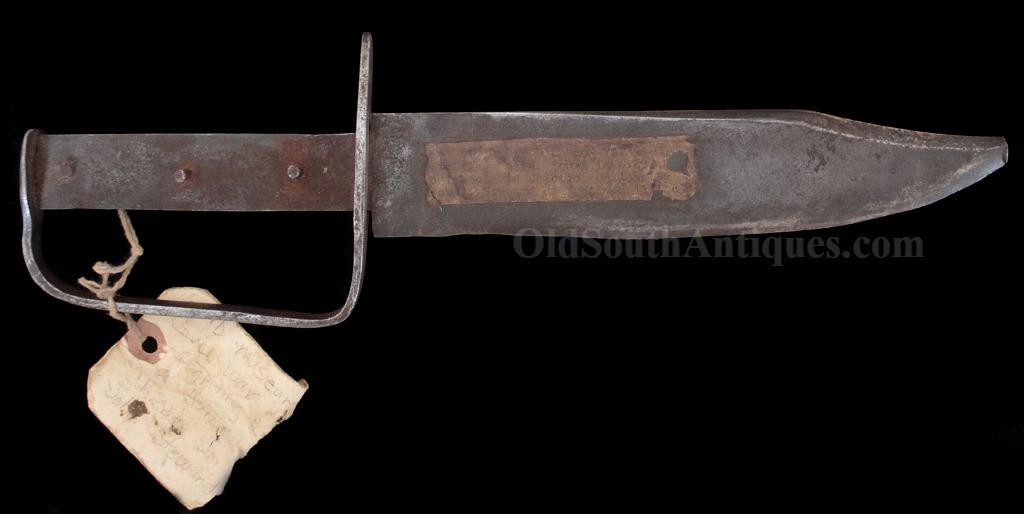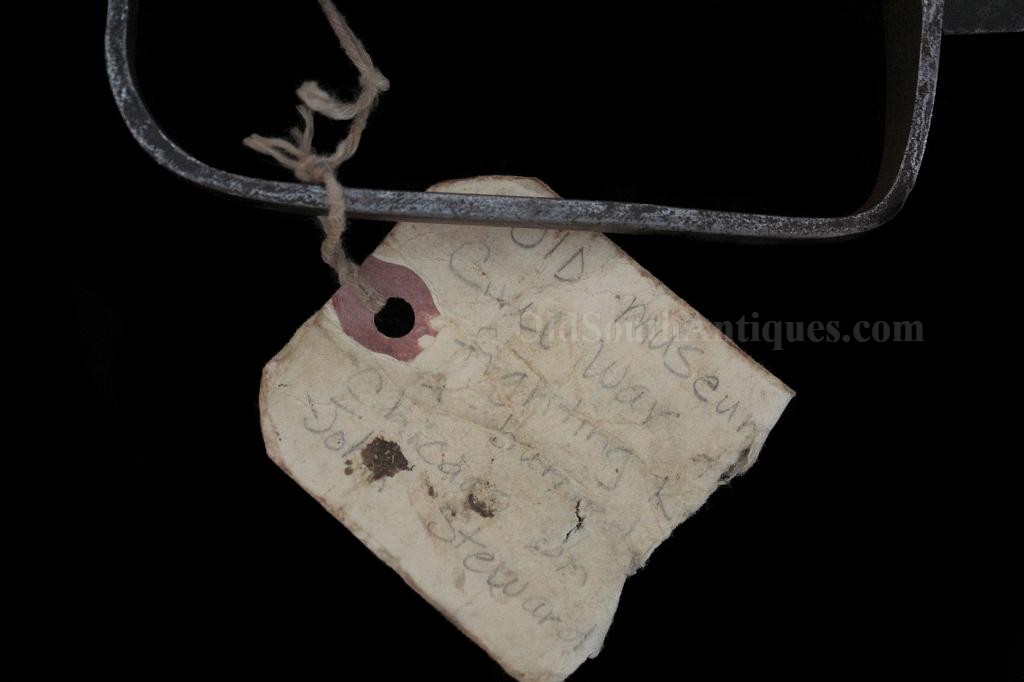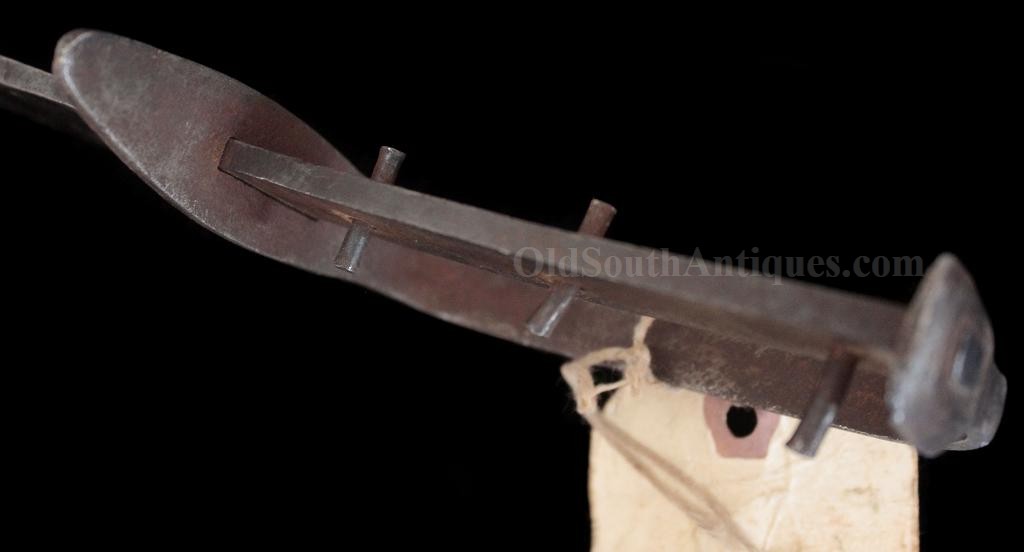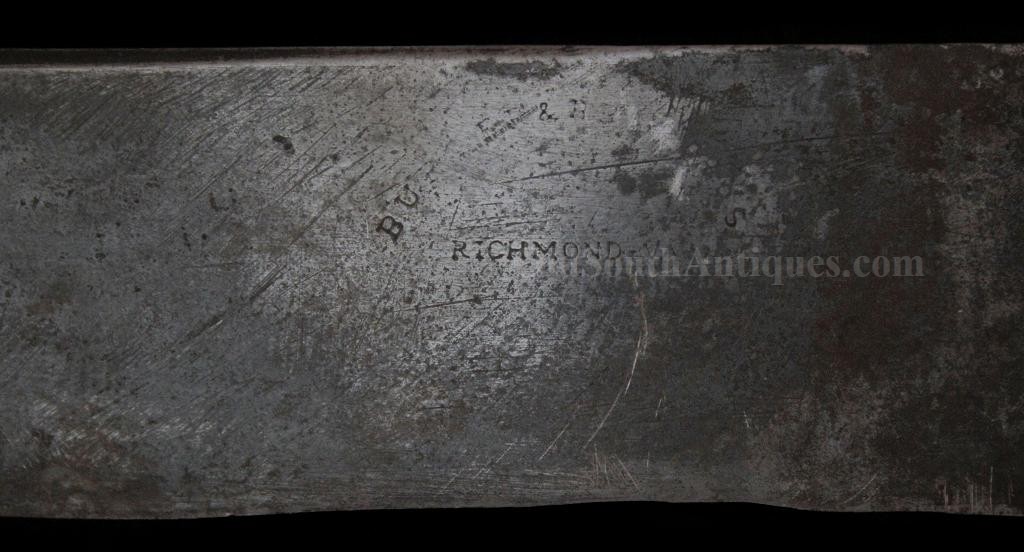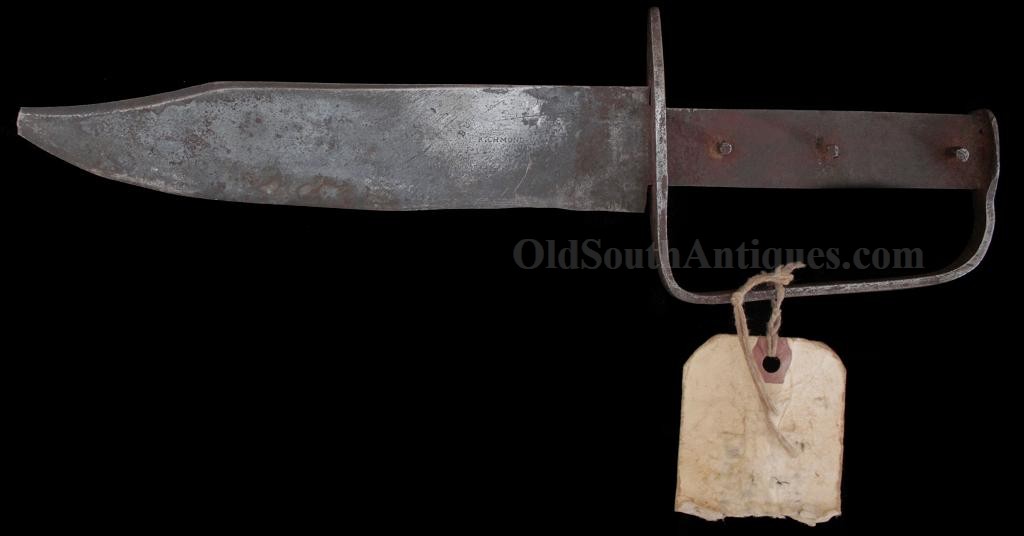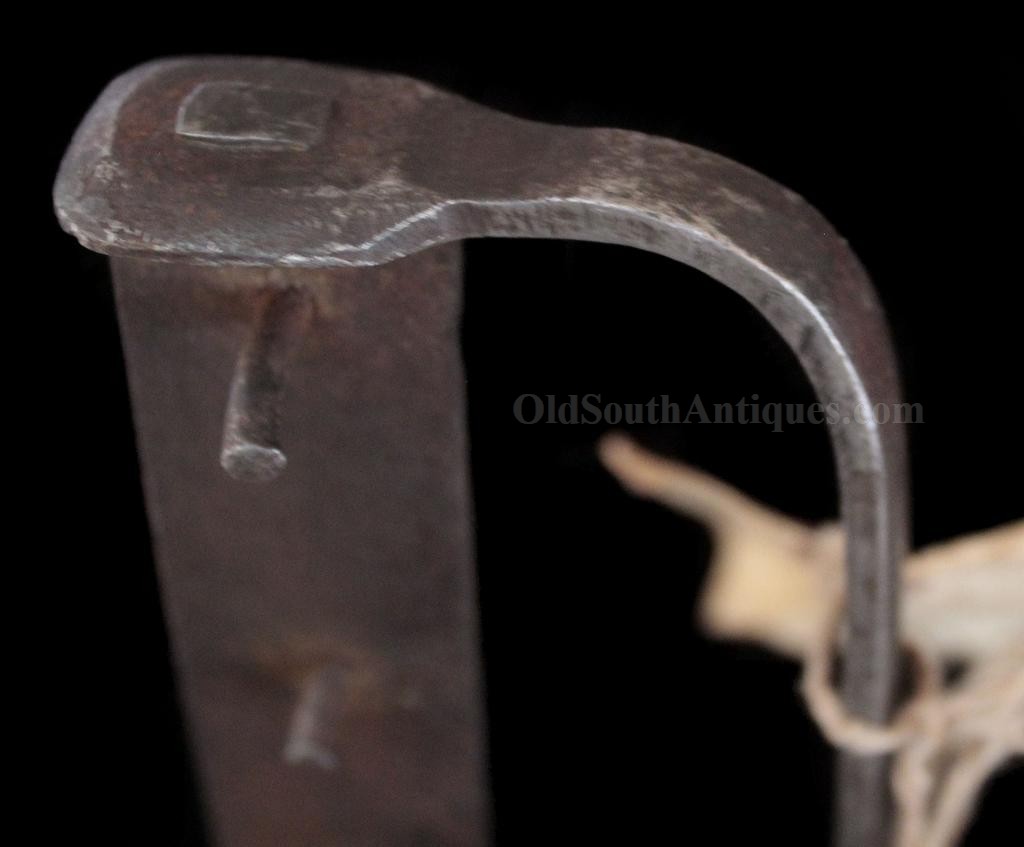
| Catalog | Past Items | Order Info | Terms/Conditions | About Us | Inventory Clearance |
This Confederate D Guard knife is extraordinary for several reason, first, it has the "BURGER & BROTHERS RICHMOND VA." Maker’s mark stamped into the blade. The knife is 13.5 inches long, originally 14 inches, with a half inch of the tip missing. The guard is very similar to their more commonly encountered D Guard, previously known as a Kenansville Cutlass. Third, it has its history pasted to the blade!
The paper label tied to it with a string is torn in two, but what is there reads:
Old Museum/Civil War/fighting/illegible/Chicago/John Steward. When complete, this was an explanation and transcription of the typed paper label that is pasted to the knife’s blade.
Though very hard to read with the naked eye, I could read the label pasted to the blade clearly under a microscope. I record it exactly as it is written, any letters that I could not clearly read I have entered ( ).
"Civil War Richmond VA
Fighting Knife found in (a) house
Outhouse in Chicago on loan by
John Steward of Evanston Il(l)inois”
The label begs the question: why was a Confederate knife hidden in an outhouse in Chicago?
Had it been taken home by a Yankee as a souvenir, there would have been no need to hide it. So, I must assume that it was hidden by a Southerner, not a Copperhead; there of course were Copperheads in Chicago, but they would not have had access to a Richmond, Virginia made knife. What Southerners came to Chicago during the War and may have needed to hide a weapon? I can come to only one reasonable possibility, that it was hidden by one of the Camp Douglas Conspirators.
In 1864 two plans for the relief of the 11,000 prisoners confined in Camp Douglas were formed. Three peace commissioners, Jacob Thompson, C. C. Clay and J. P. Holcomb had been sent from Richmond to Canada. These men frequently met with leaders of the Copperhead organizations in the North including U.S. Congressman Clement L.Vallandigham and Brigadier General Charles Walsh, head of the movement in Chicago and who had a large number of allies in the city.
In May, 1864, Jacob Thompson of Mississippi, who had been Secretary of the Interior during the administration of President Buchanan, went to Windsor, Canada, with large sums of operational funds supplied by the Confederate Government under the assumed name of Captain Carson. There he organized an expedition to release suffering prisoners at Camp Douglas. He also arranged to aid the "Knights of Liberty,” an organization of secessionists in the North, with arms and money so that they might raise an insurrection in Chicago. On the 24th of August, many previously escaped prisoners and Copperheads, after having been furnished with Confederate supplied arms in Canada, gathered in Chicago, making their general headquarters at the Richmond Hotel.
The management of the affair was entrusted to special agent Captain Thomas H. Hines, who had previously been second in command to Gen. John Morgan while Colonel Vincent Marmaduke, of Missouri and the famed St. Leger Grenfell (an Englishman, serving with Morgan) were to carry out the military program.
The date set for the attempt to liberate the Southern prisoners was August 29, 1864, when the National Democratic Convention was to assemble in Chicago. It was thought that large bodies of men who had been secretly armed might be brought into the city at that time without exciting suspicion, as it was expected the city would be so crowded that the presence of the promised force of Knights of Liberty would not excite comment.
The program also included an
attack on the city by water for which purpose reliance was placed upon a horde
of Canadian refugees, under Capt. John B. Castleman. There were some 26,500
Southern prisoners in the State at this time, of whom about 8,000 were at
Chicago, 6,000 at Rock Island, 7,500 at Springfield and 5,000 at Alton. It is
estimated that there were 4,000 Knights of Liberty in Chicago who
would be largely re-enforced. With these and the Canadian refugees the
prisoners at Camp Douglas were to be liberated, and the army thus formed was to
march upon Rock Island, Springfield and Alton prison camps. But there were
traitors within the Copperheads, and the plan was postponed when the Camp was
re-enforced by a regiment of infantry and a battery.
Shanks was permitted to escape from Camp Douglas, thereby getting in communication with the leaders of the plot who assisted to conceal him, while he faithfully apprised General Sweet of their plans. Shortly after midnight on the morning of the 7th, the day before the action was to take place, Colonel Sweet caused simultaneous arrests of the leaders to be made at their hiding-places. This caused a wholesale hiding of weapons and fleeing by the many conspirators. The following men were captured:
Captain Cantrill, Captain Traverse and Charles Walsh the Brigadier General of the Knights of Liberty who was sheltering them. A large quantity of arms and military stores were found in his barn. The famed Morgan Man, Colonel St. Leger Grenfell, Colonel W.R. Anderson, R.T. Semmes, Vincent Marmaduke, Charles T. Daniel and Buckner S. Morris.
These men were tried in Cincinnati by a military commission. Both Marmaduke and Morris were acquitted, Colonel Anderson committed suicide during the trial. Walsh, Semmes and Daniels were sentenced to the penitentiary and Colonel Grenfell was sentenced to be hung. Afterwards his sentence was commuted to life imprisonment at Dry Tortugas, a fate worse than death. He disappeared after a few years, but whether he escaped or was drowned in the attempt is debated. He had powerful and wealthy friends. His brother was a British Army General, and the British Government had tried unsuccessfully to have him released. Therefore, it is possible that he escaped, but since he never resurfaced under his own name after the War, it is likely he died in the attempt.
Daniels managed to escape and was never recaptured while Walsh and Semmes, after undergoing brief terms of imprisonment, were pardoned by President Johnson.
The traitor Shanks had a $1,000.00 bounty placed upon his worthless head and he and his new Yankee wife had to flee. Whether he was ever brought to justice is unknown. He was only a private, not really a colonel, and had a grievance because he was arrested for embezzlement in the Confederate commissary department. Naturally enough the unprincipled sided with the unprincipled.
Curses upon his ashes.
I do not consider the above positive proof that this was among the arms sent north to arm the Copperheads and Knights of Liberty, but it surely is the most likely scenario. However, I have added nothing to the price for the fascinating history outlined above; the price is based on the rarity of this desirable Richmond, Virginia maker.
Copyright © 2025 OldSouthAntiques.com All Rights Reserved.
Privacy Policy | Terms of Use
Powered by Web-Cat Copyright © 1996-2025 GrayCat Systems
